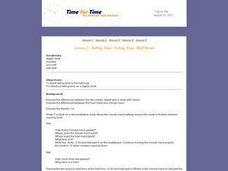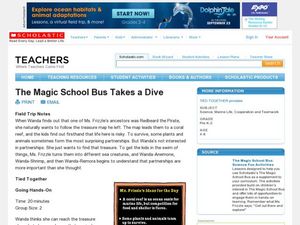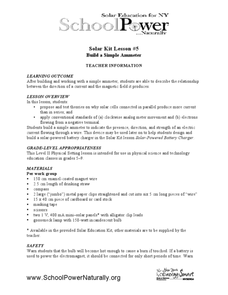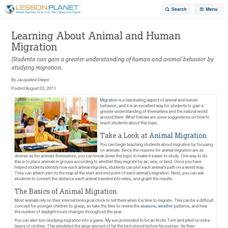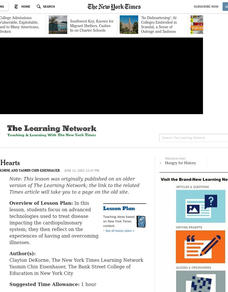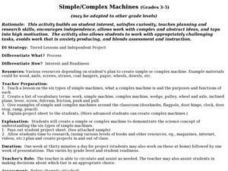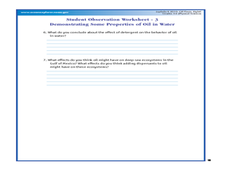Time for Time
Telling Time: Telling Time: Half Hours
The whole class discusses the differences between the two clocks: digital and a clock with hands. They discuss the differences between the hour hand and minute hand. Students are taught telling time to the half hour. They are introduced...
Curated OER
Earth Science Lesson Plans on Geologic Time
Springboard your fourth and fifth graders into the study geologic time. They will complete 7 activities to learn about geologic time and the topics most often associated with it: astronomy, creation, planet formation, volcanology,...
Curated OER
Connecting the Dots
Students consider familiar audio and imaging devices, researching and analyzing the differences between analog and digital versions. They then reflect on which versions of the technology provide a truer record over time.
Curated OER
The West the Railroads made
Students investigate the effects of time and distance for the creation of a successful railroad. In this railroad activity, students recognize the railroad's need for an exact time schedule was the cause for the creation of time...
Curated OER
Galileo: His Times & Beliefs
Students study Galileo and his scientific discoveries. They complete a series of experiments/model constructions, using 17th century equipment and procedures, to "recreate," demonstrate and explore the various discoveries of Galileo.
Discovery Education
It's Melting!
It's a race to the finish! Which ice cube will melt the fastest? Scholars discover the effect thermal energy has on melting ice. They experiment with melting ice cubes on different materials and learn that even at a consistent...
Curated OER
The Magic School Bus Takes a Dive
Students learn along with Ms. Frizzle's class. For this Magic School Bus lesson plan, students find out how partners can help run a race just as Wanda learns that survival on the coral reef often depends on cooperation.
Curated OER
The Magic School Bus Works Out
Students learn along with Ms. Frizzle's class. In this Magic School Bus lesson plan, students make a personal heart profile of an important member of their own hardworking team.
Curated OER
Measure
Students are asked what activities or things that they do each day. They are then asked do you do that in the morning, afternoon, or night? Students are then asked which of those things do you do first, second, third, and etc.
Baylor College
Heart Rate and Exercise
What is the relationship among the heart, circulation, and exercise? Your class members will explore first-hand how different physical exercises affect an individual's heart rate. They will begin by learning how to measure their own...
NOAA
Biological Oceanographic Investigations – Through Robot Eyes
How can a robot measure the length of something when we don't know how far the camera is from the object? The lesson explains the concept of perspective and many others. Scholars apply this knowledge to judge the length of fish and the...
NOAA
Biological Oceanographic Investigations – I, Robot, Can Do That!
How do you decide the best person for each job? Would it be easier if you didn't have to consider their feelings? The instructional activity begins with a discussion of underwater robots. Then groups research one of these robots and...
Curated OER
Solar Kit Lesson #5 - Build a Simple Ammeter
Emerging electricians build a simple ammeter for making measurements on an electric current. They test the placement of solar cells in both series and parallel circuits and examine the magnetic field produced by the movement of electrons...
Curated OER
The Magic School Bus Gets Swamped
Students participate in an experiment that shows them how wetlands filter dirty water. They work in groups to accomplish this experiement with the help of supervisors. A bulletin board can be created to show the plants and animals that...
Curated OER
Science: Bees: An Interdisciplinary Approach
Learners investigate the world of bees and describe their characteristics. by identifying the bees' parts, they demonstrate how these parts function. In the lab, students dissect bees and view the various parts under microscopes. ...
Curated OER
Characteristics of Living Things
Student use the scientific method to experiment with worms. In this characteristics of living things lesson, students predict and examine the reactions of worms to dry and wet soil. Students share their findings.
Curated OER
Ziplock Chemistry
Students investigate various chemical reactions when creating mixtures in ziplock baggies. In this chemistry lesson, students will recognize various chemical reactions and cite evidence. Safety and assessment strategies are included in...
Curated OER
Learning About Animal and Human Migration
Students can gain a greater understanding of human and animal behavior by studying migration.
Curated OER
Healthy Hearts
Students focus on advanced technologies used to treat disease impacting the cardiopulmonary system; they then reflect on the experiences of having and overcoming illnesses.
Curated OER
Automated Intelligence
Students redesign everyday robotic devices to increase their autonomy and their usefulness. Propose ideas that would make directly controlled robotic devices more antonymous and create posters illustrating their ideas.
Curated OER
Simple/Complex Machines
Students make a simple machine. In this physics instructional activity, students learn about six types of simple machines and the purpose of each and brainstorm examples of simple and complex machines in the classroom. Students...
Curated OER
Star Quest
Students review the concepts of the branch of science known as astronomy. They discuss stars and constellations and then view the night sky using a portable digital planetarium projector. They identify a variety of constellations using a...
Curated OER
Oil Floats, Right?
Students examine the properties in oil in water. For this mixture lesson, students read about the Lophelia II 2010: Cold Seeps and Deep Reef Expedition and look at images of deep sea ecosystems. They experiment or participate in...
Curated OER
Learning About Sounds
Learners determine the sources of sound. In this auditory discrimination lesson, students listen to animal noises and various other noises. As learners listen, they identify the sounds that they hear.
